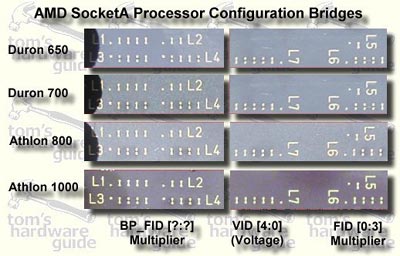WileCoyote schrijft: "Het is zo ver, nonkel Tom heeft de bruggetjes op de AMD Duron en Thunderbird ontcijferd en zijn bevindingen in een verhelderend artikeltje gepost. Uiteraard is dit goed nieuws voor de mensen die deze plakjes siliconen besteld cq in huis hebben. Vraag blijft nog hoe je het beste de bestaande bruggetjes kunt schrappen, maar het lijkt me sterk als er de komende dagen niet wat leuke ideeen naar voren komen ![]() ":
":
The next problem we've got to tackle before I'll get to the actual settings is how to open and close those copper bridges on the processors. I received several suggestions, which can be divided into two sections. The one half of my most helpful readers suggested etching the bridges with PCB-etching material.
While this solution might sound most sensible, it produces the problem that the etching agent can hardly be applied to the tiny bridge area only. The very contacts might go away as well, unless you've got top notch masking material. In this case a reversal of this operation could become close to impossible, which is obviously rather dangerous.
The other half of my readers suggested several kind of micro files or saws, going from dental equipment to optical tools. My own ideas are a glasscutter or mat cutter. Thanks for all the suggestions folks!
Closing the bridges is an actual piece of cake. Every electronic engineer will know those conductive silver pens, which can be used to fix little errors on PCBs. Those pens work perfectly to connect the two contacts and the bridge is closed.
![]() De verschillende contact bridges die de CPU vertellen wie hij is:
De verschillende contact bridges die de CPU vertellen wie hij is:
 |
